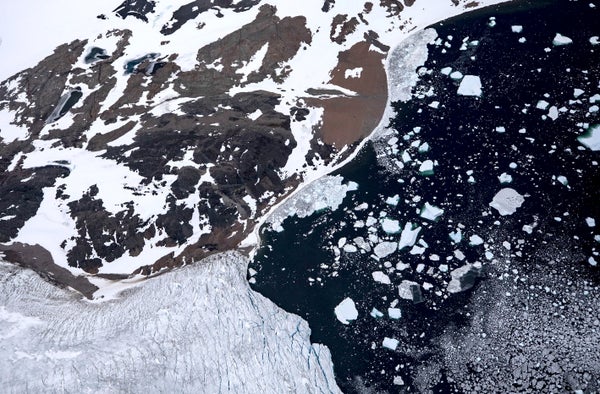Antarctic sea ice hit a stunning record-low minimum at the end of February, dropping below 772,000 square miles for the first time since satellites began observing the southern continent more than 40 years ago.
Now scientists say they’ve untangled the reasons why.
A study published yesterday in the journal Advances in Atmospheric Sciences points to a perfect storm of factors that sent Antarctic sea ice spiraling downward in the past year. Some involve natural climate cycles—while others may be influenced by human-caused climate change.
On supporting science journalism
If you're enjoying this article, consider supporting our award-winning journalism by subscribing. By purchasing a subscription you are helping to ensure the future of impactful stories about the discoveries and ideas shaping our world today.
A combination of La Niña conditions and other climate fluctuations in the Southern Hemisphere helped strengthen a natural weather pattern in the Southern Ocean known as the Amundsen Sea Low, or ASL. The ASL is kind of like a permanent hurricane, swirling off the coast of West Antarctica. It’s always there, but it’s sometimes stronger and sometimes weaker depending on other climate conditions.
When the ASL is stronger, it often has a destructive effect on Antarctic sea ice.
At the same time, oceans worldwide reached their hottest levels on record in 2021 (Climatewire, Jan. 12). And the Southern Ocean is exhibiting some of the highest levels of long-term warming. That’s an added threat to Antarctic sea ice, researchers have warned. Warmer waters can thin the ice from the bottom up, which may make it break more easily under stress and melt faster during the summer months.
The combination of long-term ocean warming, plus the strong ASL and other natural climate patterns in the Southern Hemisphere during the past year, likely set up the right conditions for strong melting as the Antarctic summer approached.
Sea ice was thinner than normal to begin with in parts of the Southern Hemisphere in 2021. It also began melting earlier than usual at the start of the Antarctic spring in September.
Thanks to the intense ASL and other stronger-than-usual wind patterns around Antarctica, sea ice in parts of the Southern Ocean drifted rapidly north into warmer waters, where it melted faster than usual. As the ice disappeared, the ocean was able to absorb more sunlight and heat, further warming up the waters and accelerating the melting.
The unusually strong wind patterns also carried more heat into certain parts of the Southern Ocean, speeding up the melting even more.
On Feb. 25 of this year, near the end of the Antarctic summer, the sea ice hit its record low at 1.9 million square kilometers (about 772,000 square miles).
It’s the latest event in a puzzling trajectory for Southern Ocean sea ice. For most of the satellite record, beginning in the 1970s, Antarctic sea ice was actually expanding. That’s in stark contrast to the trend at the other end of the world, where Arctic sea ice has been swiftly declining for decades in response to global warming.
But beginning around 2014, the pattern abruptly reversed. Antarctic sea ice started shrinking rapidly. It hit a record-low minimum in 2017, rebounded slightly around 2020, and then plummeted to another record low in 2022.
These trends have perplexed Antarctic scientists, who are still debating the exact causes. Many experts believe natural climate cycles have probably played a large role.
The recovery of the infamous Antarctic ozone hole, which has been gradually healing for the last three decades, may have also had a hand in things. Some studies suggest that the closing of the ozone hole has influenced wind patterns in the Southern Hemisphere, which in turn can affect the movement and behavior of Antarctic sea ice.
And human-caused climate change may have also played a part in recent events, although its exact effect is still uncertain.
Unlike the Arctic, where warming has had a clear and devastating long-term influence on sea ice, conditions are more complicated in the Antarctic. The Southern Ocean is much more vulnerable to the impacts of other natural climate fluctuations, which don’t always have the same kinds of effects as human-caused warming.
For now, climate change may not be the strongest influence out of all the elements affecting Antarctic sea ice. But eventually, as the world continues to warm, it’s likely to become a more dominant factor.
And climate change is already taking a toll on other aspects of the Antarctic system.
Glaciers in West Antarctica are spewing ice into the ocean at accelerating rates as warm ocean water melts them from the bottom up. Currently, the Antarctic ice sheet is losing about 200 billion metric tons of ice each year, raising global sea levels.
And in East Antarctica, which has been comparatively stable compared to other parts of the ice sheet, conditions are starting to shift. Some glaciers are beginning to lose ice at faster rates.
Last month, just a few weeks after the record-low sea ice event, a shocking heat wave sent temperatures in East Antarctica soaring to unprecedented heights. In some areas, they reached a jaw-dropping 70 degrees above normal—likely a new record for the highest above-normal temperatures observed at any weather station in the world.
Reprinted from E&E News with permission from POLITICO, LLC. Copyright 2022. E&E News provides essential news for energy and environment professionals.
